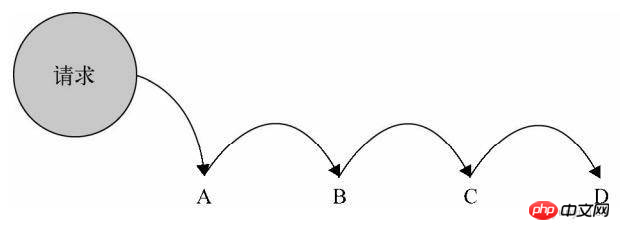本篇文章给大家带来的内容是关于js设计模式:什么是职责链模式?js职责链模式的介绍,有一定的参考价值,有需要的朋友可以参考一下,希望对你有所帮助。
什么是职责链模式?

重要性:4 星,在项目中能对 if-else 语句进行优化
定义:避免请求发送者与接收者耦合在一起,让多个对象都有可能接收请求,将这些对象连接成一条链,并且沿着这条链传递请求,直到有对象处理它为止。
主要解决:职责链上的处理者负责处理请求,客户只需要将请求发送到职责链上即可,无须关心请求的处理细节和请求的传递,所以职责链将请求的发送者和请求的处理者解耦了。
何时使用:在处理消息的时候以过滤很多道。
如何解决:拦截的类都实现统一接口。
js职责链模式应用实例: 1、红楼梦中的"击鼓传花"。 2、JS 中的事件冒泡。 3、JAVA WEB 中 Apache Tomcat 对 Encoding 的处理,Struts2 的拦截器,jsp servlet 的 Filter。
js职责链模式优点: 1、降低耦合度。它将请求的发送者和接收者解耦。 2、简化了对象。使得对象不需要知道链的结构。 3、增强给对象指派职责的灵活性。通过改变链内的成员或者调动它们的次序,允许动态地新增或者删除责任。 4、增加新的请求处理类很方便。
js职责链模式缺点: 1、不能保证请求一定被接收。 2、系统性能将受到一定影响,而且在进行代码调试时不太方便,可能会造成循环调用。 3、可能不容易观察运行时的特征,有碍于除错。
js职责链模式使用场景: 1、有多个对象可以处理同一个请求,具体哪个对象处理该请求由运行时刻自动确定。 2、在不明确指定接收者的情况下,向多个对象中的一个提交一个请求。 3、可动态指定一组对象处理请求。
js职责链模式场景
场景:某电商针对已付过定金的用户有优惠政策,在正式购买后,已经支付过 500 元定金的用户会收到 100 元的优惠券,200 元定金的用户可以收到 50 元优惠券,没有支付过定金的用户只能正常购买。
// orderType: 表示订单类型,1:500 元定金用户;2:200 元定金用户;3:普通购买用户
// pay:表示用户是否已经支付定金,true: 已支付;false:未支付
// stock: 表示当前用于普通购买的手机库存数量,已支付过定金的用户不受此限制
const order = function( orderType, pay, stock ) {
if ( orderType === 1 ) {
if ( pay === true ) {
console.log('500 元定金预购,得到 100 元优惠券')
} else {
if (stock > 0) {
console.log('普通购买,无优惠券')
} else {
console.log('库存不够,无法购买')
}
}
} else if ( orderType === 2 ) {
if ( pay === true ) {
console.log('200 元定金预购,得到 50 元优惠券')
} else {
if (stock > 0) {
console.log('普通购买,无优惠券')
} else {
console.log('库存不够,无法购买')
}
}
} else if ( orderType === 3 ) {
if (stock > 0) {
console.log('普通购买,无优惠券')
} else {
console.log('库存不够,无法购买')
}
}
}
order( 3, true, 500 ) // 普通购买,无优惠券下面用职责链模式改进代码
const order500 = function(orderType, pay, stock) {
if ( orderType === 1 && pay === true ) {
console.log('500 元定金预购,得到 100 元优惠券')
} else {
order200(orderType, pay, stock)
}
}
const order200 = function(orderType, pay, stock) {
if ( orderType === 2 && pay === true ) {
console.log('200 元定金预购,得到 50 元优惠券')
} else {
orderCommon(orderType, pay, stock)
}
}
const orderCommon = function(orderType, pay, stock) {
if (orderType === 3 && stock > 0) {
console.log('普通购买,无优惠券')
} else {
console.log('库存不够,无法购买')
}
}
order500( 3, true, 500 ) // 普通购买,无优惠券改造后可以发现代码相对清晰了,但是链路代码和业务代码依然耦合在一起,进一步优化:
// 业务代码
const order500 = function(orderType, pay, stock) {
if ( orderType === 1 && pay === true ) {
console.log('500 元定金预购,得到 100 元优惠券')
} else {
return 'nextSuccess'
}
}
const order200 = function(orderType, pay, stock) {
if ( orderType === 2 && pay === true ) {
console.log('200 元定金预购,得到 50 元优惠券')
} else {
return 'nextSuccess'
}
}
const orderCommon = function(orderType, pay, stock) {
if (orderType === 3 && stock > 0) {
console.log('普通购买,无优惠券')
} else {
console.log('库存不够,无法购买')
}
}
// 链路代码
const chain = function(fn) {
this.fn = fn
this.sucessor = null
}
chain.prototype.setNext = function(sucessor) {
this.sucessor = sucessor
}
chain.prototype.init = function() {
const result = this.fn.apply(this, arguments)
if (result === 'nextSuccess') {
this.sucessor.init.apply(this.sucessor, arguments)
}
}
const order500New = new chain(order500)
const order200New = new chain(order200)
const orderCommonNew = new chain(orderCommon)
order500New.setNext(order200New)
order200New.setNext(orderCommonNew)
order500New.init( 3, true, 500 ) // 普通购买,无优惠券重构后,链路代码和业务代码彻底地分离。假如未来需要新增 order300,那只需新增与其相关的函数而不必改动原有业务代码。
另外结合 AOP 还能简化上述链路代码:
// 业务代码
const order500 = function(orderType, pay, stock) {
if ( orderType === 1 && pay === true ) {
console.log('500 元定金预购,得到 100 元优惠券')
} else {
return 'nextSuccess'
}
}
const order200 = function(orderType, pay, stock) {
if ( orderType === 2 && pay === true ) {
console.log('200 元定金预购,得到 50 元优惠券')
} else {
return 'nextSuccess'
}
}
const orderCommon = function(orderType, pay, stock) {
if (orderType === 3 && stock > 0) {
console.log('普通购买,无优惠券')
} else {
console.log('库存不够,无法购买')
}
}
// 链路代码
Function.prototype.after = function(fn) {
const self = this
return function() {
const result = self.apply(self, arguments)
if (result === 'nextSuccess') {
return fn.apply(self, arguments) // 这里 return 别忘记了~
}
}
}
const order = order500.after(order200).after(orderCommon)
order( 3, true, 500 ) // 普通购买,无优惠券职责链模式比较重要,项目中能用到它的地方会有很多,用上它能解耦 1 个请求对象和 n 个目标对象的关系。
相关推荐:
以上是js设计模式:什么是职责链模式?js职责链模式的介绍的详细内容。更多信息请关注PHP中文网其他相关文章!
 JavaScript引擎:比较实施Apr 13, 2025 am 12:05 AM
JavaScript引擎:比较实施Apr 13, 2025 am 12:05 AM不同JavaScript引擎在解析和执行JavaScript代码时,效果会有所不同,因为每个引擎的实现原理和优化策略各有差异。1.词法分析:将源码转换为词法单元。2.语法分析:生成抽象语法树。3.优化和编译:通过JIT编译器生成机器码。4.执行:运行机器码。V8引擎通过即时编译和隐藏类优化,SpiderMonkey使用类型推断系统,导致在相同代码上的性能表现不同。
 超越浏览器:现实世界中的JavaScriptApr 12, 2025 am 12:06 AM
超越浏览器:现实世界中的JavaScriptApr 12, 2025 am 12:06 AMJavaScript在现实世界中的应用包括服务器端编程、移动应用开发和物联网控制:1.通过Node.js实现服务器端编程,适用于高并发请求处理。2.通过ReactNative进行移动应用开发,支持跨平台部署。3.通过Johnny-Five库用于物联网设备控制,适用于硬件交互。
 使用Next.js(后端集成)构建多租户SaaS应用程序Apr 11, 2025 am 08:23 AM
使用Next.js(后端集成)构建多租户SaaS应用程序Apr 11, 2025 am 08:23 AM我使用您的日常技术工具构建了功能性的多租户SaaS应用程序(一个Edtech应用程序),您可以做同样的事情。 首先,什么是多租户SaaS应用程序? 多租户SaaS应用程序可让您从唱歌中为多个客户提供服务
 如何使用Next.js(前端集成)构建多租户SaaS应用程序Apr 11, 2025 am 08:22 AM
如何使用Next.js(前端集成)构建多租户SaaS应用程序Apr 11, 2025 am 08:22 AM本文展示了与许可证确保的后端的前端集成,并使用Next.js构建功能性Edtech SaaS应用程序。 前端获取用户权限以控制UI的可见性并确保API要求遵守角色库
 JavaScript:探索网络语言的多功能性Apr 11, 2025 am 12:01 AM
JavaScript:探索网络语言的多功能性Apr 11, 2025 am 12:01 AMJavaScript是现代Web开发的核心语言,因其多样性和灵活性而广泛应用。1)前端开发:通过DOM操作和现代框架(如React、Vue.js、Angular)构建动态网页和单页面应用。2)服务器端开发:Node.js利用非阻塞I/O模型处理高并发和实时应用。3)移动和桌面应用开发:通过ReactNative和Electron实现跨平台开发,提高开发效率。
 JavaScript的演变:当前的趋势和未来前景Apr 10, 2025 am 09:33 AM
JavaScript的演变:当前的趋势和未来前景Apr 10, 2025 am 09:33 AMJavaScript的最新趋势包括TypeScript的崛起、现代框架和库的流行以及WebAssembly的应用。未来前景涵盖更强大的类型系统、服务器端JavaScript的发展、人工智能和机器学习的扩展以及物联网和边缘计算的潜力。
 神秘的JavaScript:它的作用以及为什么重要Apr 09, 2025 am 12:07 AM
神秘的JavaScript:它的作用以及为什么重要Apr 09, 2025 am 12:07 AMJavaScript是现代Web开发的基石,它的主要功能包括事件驱动编程、动态内容生成和异步编程。1)事件驱动编程允许网页根据用户操作动态变化。2)动态内容生成使得页面内容可以根据条件调整。3)异步编程确保用户界面不被阻塞。JavaScript广泛应用于网页交互、单页面应用和服务器端开发,极大地提升了用户体验和跨平台开发的灵活性。
 Python还是JavaScript更好?Apr 06, 2025 am 12:14 AM
Python还是JavaScript更好?Apr 06, 2025 am 12:14 AMPython更适合数据科学和机器学习,JavaScript更适合前端和全栈开发。 1.Python以简洁语法和丰富库生态着称,适用于数据分析和Web开发。 2.JavaScript是前端开发核心,Node.js支持服务器端编程,适用于全栈开发。


热AI工具

Undresser.AI Undress
人工智能驱动的应用程序,用于创建逼真的裸体照片

AI Clothes Remover
用于从照片中去除衣服的在线人工智能工具。

Undress AI Tool
免费脱衣服图片

Clothoff.io
AI脱衣机

AI Hentai Generator
免费生成ai无尽的。

热门文章

热工具

螳螂BT
Mantis是一个易于部署的基于Web的缺陷跟踪工具,用于帮助产品缺陷跟踪。它需要PHP、MySQL和一个Web服务器。请查看我们的演示和托管服务。

记事本++7.3.1
好用且免费的代码编辑器

MinGW - 适用于 Windows 的极简 GNU
这个项目正在迁移到osdn.net/projects/mingw的过程中,你可以继续在那里关注我们。MinGW:GNU编译器集合(GCC)的本地Windows移植版本,可自由分发的导入库和用于构建本地Windows应用程序的头文件;包括对MSVC运行时的扩展,以支持C99功能。MinGW的所有软件都可以在64位Windows平台上运行。

PhpStorm Mac 版本
最新(2018.2.1 )专业的PHP集成开发工具

SublimeText3汉化版
中文版,非常好用






